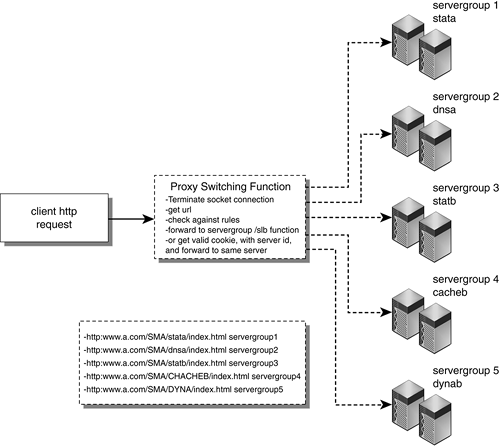Layer 7 Switching
| < Day Day Up > |
| The recent explosive demand for application hosting and increased security fueled the demand for a new concept called content switching, also known as Layer 7 switching, proxy switching, or URL switching. This switching technology basically inspects the payload, which is expected to be some HTTP request, such as a static or dynamic Web page. The content switch searches for a certain string, and if there is a match, it takes some type of action. For example, the content switch might rewrite the content or redirect it to a pool of servers that specializes in these services or to a caching server for increased performance. The main idea is that a forwarding decision is made based on the application data, not traditional Layer 2 or Layer 3 destination network addresses. Some major technical challenges arise in performing this type of processing. The first is a tremendous performance impact. In traditional Layer 2 and Layer 3 processing, the destination addresses and corresponding egress port are found by looking at a fixed offset in the packet. This allows for extremely cheap and fast ASICs. Usually, the packet header is read in from the MAC and copied into SRAM, which has an access time of around five nanoseconds. The variable size and bulky payload are usually copied into DRAM, which has a higher initial setup time. The forwarding decision requires two SRAM memory accesses, where the header is read, modified, written, and a quick lookup is performed usually a Telecommunications Access Method (TCAM) or Patricia Tree lookup in SRAM, which takes a few nanoseconds. However, for Layer 7 forwarding decisions, almost all commercial switches, except the Extreme Px1, must perform this function in much slower CPU, running a real-time operating system, such as VxWorks. The payload, which resides in DRAM, must be read, processed, and written. This string search is also time intensive. (There have been recent advances in Layer 7 technology such as that offered by Solidum and PMC-Sierras ClassiPI, which perform this at wirespeed rates. However, at the time of this writing, we are not aware of any major switch manufacturer using this technology.) This operation takes orders of magnitude more time. NAT can be extended not only to hide internal private IP addresses but also to base packet forwarding decisions on the payload. There are two approaches to accomplish this function:
This section describes an application gateway approach to NAT and performing Layer 7 processing. FIGURE 4-9 shows an overview of the functional content switching model. Figure 4-9. Content Switching Functional Model Content switching with full network address translation (NAT) serves the following purposes:
FIGURE 4-9 shows that the client's socket connection is terminated by the proxy function. The proxy retrieves as much of the URL as is needed to make a decision based on the retrieved URL. In FIGURE 4-9, various URLs map to various server groups, which are VIP addresses. The proxy determines whether to forward the URL directly or pass it off to a server load-balancing function that is waiting for traffic destined to the server group. The proxy is configured with a VIP address, so the switch forwards all client requests destined to this VIP address to the proxy function. The proxy function also rewrites the IP header, particularly the source IP and port, so that the server sends back the requested data to the proxy, not to the client directly. Network Address TranslationNetwork Address Translation (NAT) is a critical component for security and proper traffic direction. There are two basic types of NAT: half and full. Half NAT rewrites the destination IP address and MAC address to a redirected location such as a Web cache, which returns the packet directly to the client because the source IP address is unchanged. Full NAT is where the socket connection is terminated by a proxy, so the source IP and MAC are changed to that of the proxy server. NAT serves the following purposes:
NAT is configured with a set of filters, usually a 5-tuple Layer 3 rule. If the incoming traffic matches a certain filter rule, the packet IP header is rewritten or another socket connection is initiated to the target server, which itself can be changed, depending on the particular rule. NAT is often combined with other IP services such as SLB and content switching. The basic idea is that the client and servers are completely decoupled from each other, and the NAT device manages the IP address conversions, while the partner service is responsible for another decision such as determining which server will handle the request based on load or other rules. |
| < Day Day Up > |
EAN: 2147483647
Pages: 116